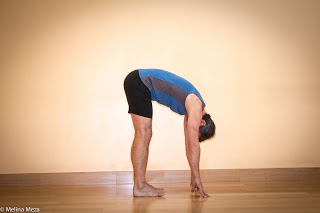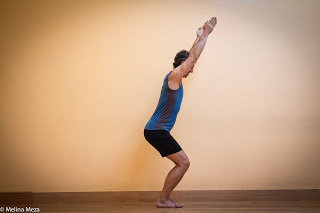by Baxter
I was delighted to see Nina’s recent post Bending Over Differently because I, too, came across this same information on March 1st, when my friend and fellow yoga teacher Perry Chattler shared the NPR article The Lost Art of Bending Over: How Other Cultures Spare Their Spines with me. It was so encouraging for me to see people doing what we would consider “back-breaking” work and not breaking their backs! And it seemed like a great way to get your hands safely down to the ground. After my first read and watch though the embedded video, I wrote back to Perry, “This makes me wonder why do we even teach/practice Standing Forward Bend (Uttanasana)?”
And his response was, “How about teaching Fig Leaf asana instead?”
So that is exactly what I started to do, playing with it in my home practice first and then teaching it in all my classes and my workshops over the last month.
Part of my motivation for doing so was personal: I have very tight hamstrings. Although I have improved my flexibility in this area, when I do Standing Forward Bend, my pelvis only rotates to about parallel with the floor before it stops moving due to hamstring tightness and my spine starts to round into the forward flexion action that tends to stress the cushioning discs between the lower spinal bones.

So, although I can do the pose with straight legs, I don’t know that I should do it that way. And I do tend to bend my knees a bit in the pose, especially at the start of practice, as for me bending the knees tends to release some of the tension in the hamstrings, at least when working up to the classic version of Standing Forward Bend.
A second motivating factor is what I have observed about my students over the years. Except for those with very flexible hamstrings and very mobile hip joints, the vast majority tend to stop “hip-hinging” (as it was called in the NPR story) and start spine rounding about half way into their forward bends, increasing the possibility of future injury to the vulnerable structures of the lower spine.
Finally, in my dedicated Back Care Yoga Class, due to the risk of re-aggravating the lower back for those, I have not taught Standing Forward Bend (Uttanasana) for many years in that class. Instead, we work on hamstring stretching in other, safer ways, such as Reclined Leg Stretch pose with a strap, Legs Up the Wall pose, Wall Downward-Facing Dog variations, or Dynamic Downward-Facing Dog pose with slight bend to knees and attention to maintaining a neutral spine.

In sequences where I might normally add a Standing Forward Bend, for example after an asymmetric standing pose such as Triangle pose, we do Powerful pose instead, which involves some hip-hinging when done properly.

And over the last few weeks, I have introduced this new way of bending, which I have been calling “Fig-Leaf Forward Fold,” much to their delight.
In reviewing the NPR article and Nina’s wonderful piece on this topic, some clarifying thoughts about the hamstrings seemed worth reviewing. The hamstrings cross two major joints, the back of the hip joint and the back of the knee joint. When this group of muscles actively contract and shorten actively, they can have the following effects on those joints:
- Rocking the pelvis backwards (the opposite of hip-hinging the pelvis forward we have been discussing).
- Moving the upper leg bone backwards (like the back leg in Warrior 1).
- Bending the knee.
- Combining the above actions, such as in Bridge pose or Bow pose.
So any pose or action that does the opposite of these movements (forward bends the hip, flexes the upper leg bone forward, straightens the knees, or any combination) puts the hamstrings under greater tension and may elicit the feeling of stretch for you. However, in the hip-hinging forward bend described in this article, two “balancing” actions take place at the hips and knees. The first is the forward hinge of the hips, which puts more tension onto the hamstrings. The second is bending of the knees as much as they need to in order to keep the spine neutral as the upper body approaches parallel with the floor, which tends to lessen the tension on the hamstrings. This second action makes it possible for those with already tight hamstrings to do this version of forward bending; the hamstrings may feel like they are still stretching somewhat, but not to the degree you’d feel in Standing Forward Bend (Uttanasana). At least this has been my personal experience and that of many of my students.
The other important factor about the hamstrings is that they are not passively stretching when going into and maintaining this pose. They are actually maintaining some contraction on the way down, a lengthening type of contraction called “eccentric contraction,” which allows you to gracefully come into the pose without suddenly dropping down. And once your are at the right spot with your torso parallel to the floor while keeping the natural curve in your lower back, the hamstrings are isometrically contracting to keep you in position until you decide to stand back up. So it may be that the sensation that you are feeling and calling “stretch” is actually really muscle contraction or a bit of both stretching and contraction! Here is a video practice for trying it out on your own.
As I considered the possibility of letting go of doing Standing Forward Bend (Uttanasana), I thought of one particular place where it shows up as a transitional pose: in the Sun Salutation. So, I practiced and have taught the Sun Salutation with the Fig Leaf Forward Fold at the beginning and end of each cycle of Sun Salutations and it works! However, I have had to remind folks when stepping forward from High Lunge to the front of the mat to keep their knees somewhat bent and spine parallel with the floor when getting ready to come up, as their habit usually leads them to step forward into Standing Forward Bend with straight legs and a rounded back. Video coming soon!
Now I admit that Uttanasana is probably not going away anytime soon, and for some practitioners it does have some benefits we have touted here in the past, such as being a quieting pose (it is a partial inversion that can trigger the relaxation response). So in reality, as you consider what do about integrating this new way of bending into your practice and life, it will be a balancing act between the benefits and risks of keeping Standing Forward Bend in your practice and the benefits and risks of adding in Fig Leaf Forward Fold (which could be difficult for those with bad knees, for example). Some of you who are very tight could opt for a modified version of Standing Forward Bend with some bending of the knees while some of you will want to experiment with the full Fig Leaf Forward Fold in your practice. But perhaps all of us should try it the next time we go to pick up that pair of socks from the bedroom floor or weed the garden, as one of my Back Care students successfully did over the weekend!
Follow Baxter Bell, MD on YouTube, Facebook, and Instagram. For upcoming workshops and retreats and for info on Baxter see baxterbell.com.
Follow Yoga for Healthy Aging on Facebook ° To order Yoga for Healthy Aging: A Guide to Lifelong Well-Being, go to Amazon, Shambhala, Indie Bound or your local bookstore.


I've been doing this in my classes now for sometime and have it very effective for all of my students, even if they can do Uttanasana safely. The knee issue you bring seems to be less problematic when I remember to remind my students to put their weight in their heels. It actually seems to strengthen the knees. The minute they go forward with their weight, if their vulnerability is their knees or low back, the pose is less effective and possibly even dangerous. Thanks for sharing. It's nice to know other teachers are discovering the same thing
Baxter, Nice to know that you are rethinking the forward bends with extended knees. There are many teachers including myself who stopped doing these poses over 20 years ago. This is just the tip of the iceberg in what needs to change in yoga. Please check out my article entitled. Stop Stretching Your Hamstings https://www.huffingtonpost.com/entry/stop-stretching-your-hamstrings_us_58cdb802e4b0e0d348b34421